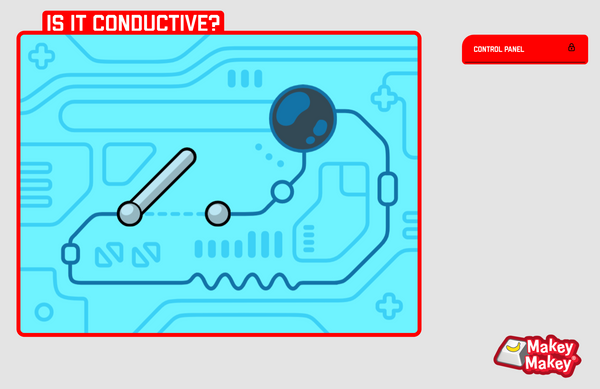Makey Makey works by alligator clipping into everyday things that have some conductivity. When you hook an alligator clip into a banana and you hold an alligator clip connected to EARTH, you are actually the conductive stuff that closes the circuit and makes Makey Makey work! But what materials can we use with Makey Makey besides bananas? What does it mean for an item to be conductive? or an insulator? or even a resistor? Let's set up a simple experiment to find out! In this lesson, you will make a conductivity testing board to test items for conductivity; learn that everything in the world is either or conductive or an insulator; and start to ideate inventions with everyday stuff you can find in your home.
| Vocabulary and Building an Experiment |
|
Invention Literacy Vocabulary: A conductor is any item that allows electrons to flow through it with little effort. If an item has any conductivity, Makey Makey will detect it. Most metals are great conductors! Pure water is actually an insulator, once water comes in contact with things like salt, humans, etc, it becomes contaminated. Because of this, free ions in water are what make water conductive. Conductivity is changed by humidity and temperatures. An insulator is any item that does not allow electrons to flow through it. Things like masking tape, hot glue, paper, are insulators that do not allow electrons to flow Prototyping is the first step to inventing. A prototype is an early or beginning model of an idea (generally an invention.) Inventors prototype ideas to test the concept of their inventions. If a prototype is still buggy or doesn't work right, an inventor will create another version of their idea. Iteration is the next step of prototyping. An inventor will continue to draft and rework their ideas by making more versions or iterations of a design idea. Once you start inventing, you'll want to make multiple versions of your idea to make sure you have a successful prototype or invention idea! Build a Testing Station
Did you know everything in this world is either a conductor or an insulator? In this lesson, we experiment with all sorts of objects to find out what is conductive so you can start designing your own inventions. Here is a quick example of what your finished experiment will look like. Now grab some foil and a piece of cardboard and let's make your own "Is it Conductive?" testing station! Make sure to the “Is it Conductive?" Make sure to print out your t-chart, or make your own chart on paper so you can record what is conductive and what is an insulator. Test an item by laying it across the conductive tape traces. If it is conductive, the game will tell you! Sometimes, it helps to use a plastic ruler to press down on the item so you don't accidentally set off the conductive radar with your hands! Label the item in your t-chart as you test them!
Link: Is it Conductive?
Discussion Questions:
|
|
|
| Conductor or Insulator? What's the Difference? |
|
A Little Science Behind Makey Makey Makey Makey is a resistive touch board that means it is programmed to sense when an item is conductive. An item that is conductive is a material that allows electrons to flow, while an insulator is a material that does not allow electrons to flow. The Makey Makey is also programmed to send a signal to your computer when you complete a circuit that you've pressed a computer key. Try using the Makey Makey to be your SPACE key like in this image!
In the next few lessons, we will teach you how to draw circuits and code those circuits! Head to the next lesson to make a drawing into a playable instrument!
New Apps Challenge!Your journey to inventing begins here! Now that you know how to craft a circuit and how to test items with Makey Makey, you can start building your own inventions! When we learn how things work so we can make new things, we call this Invention Literacy. Makey Makey was created to help you see the world as a construction kit! One of the coolest things about Makey Makey is you can use it to prototype new inventions and ideas. What is a prototype? It's like a rough draft of an invention. Since you can use everyday items from around the house to create inventions, Makey Makey is a great way to make a rough draft of an invention idea! Each draft of your invention is called an iteration. Can you invent a controller for our new apps? We'd love to see your inventions, so share them on social. And if you aren't ready for the challenge, head to the next lesson to make a drawing into a playable instrument! In the next few lessons, we will teach you how to draw circuits and code your own projects! |
Supplies
- Makey Makey
- A piece of cardboard
- Conductive base: HVAC tape or kitchen foil
- A ruler (It helps when testing materials, so you don't accidentally complete the circuit with your touch!)
- Lots of items for testing: Apples, plants, cotton, stuff around your house!
- Print or Create an "Conductive/Non-Conductive" chart in your Science journal
- Makey Makey
- Laptop with "Is it Conductive?" Plug and Play App















